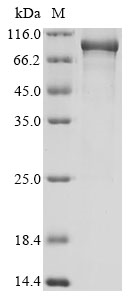Recombinant Human Transmembrane protease serine 2 (TMPRSS2), Biotinylated, is produced in E. coli and contains amino acids 106-492 of the human protein. This partial protein carries an N-terminal MBP tag and a C-terminal 6xHis-Avi tag, which allows for various experimental applications. The product shows purity greater than 85% as determined by SDS-PAGE, meeting quality standards for research use.
TMPRSS2 is a serine protease that participates in various biological processes and appears to play a key role in proteolytic processing. It's involved in cleaving specific proteins and takes part in important cellular pathways, including those related to viral entry mechanisms. Because of its involvement in these critical pathways, TMPRSS2 has become a significant focus of research in several biochemical and biomedical studies.
Potential Applications
Note: The applications listed below are based on what we know about this protein's biological functions, published research, and experience from experts in the field. However, we haven't fully tested all of these applications ourselves yet. We'd recommend running some preliminary tests first to make sure they work for your specific research goals.
The protein is expressed in E. coli as a partial fragment (106–492 aa) with an N-terminal MBP tag, C-terminal 6xHis-Avi tag, and biotinylation. While the MBP tag enhances solubility, E. coli often produces misfolded proteins or lacks native disulfide bonds/catalytic microenvironments critical for TMPRSS2’s serine protease activity. Biotinylation depends entirely on correct tertiary/quaternary structure for stable streptavidin binding. No data on functional bioactivity (e.g., enzyme kinetics for protease activity) or structural integrity (e.g., circular dichroism for secondary structure, thermal shift assays for stability) is provided—thus, the protein may be partially folded but lacks validated biological activity.
1. Protease Inhibitor Screening and Characterization
This recombinant TMPRSS2 (106–492 aa) could serve as a target for screening serine protease inhibitors, but only after validating its enzymatic activity (e.g., using fluorescent substrate hydrolysis assays). The biotin tag enables immobilization for high-throughput screening, but accurate assessment of inhibitor affinity/specificity requires confirmed proteinase function. MBP/His tags aid purification, but results depend on the protein retaining native catalytic conformation.
2. Protein-Protein Interaction Studies
Biotinylated TMPRSS2 can be used in pull-down assays to identify binding partners, but its utility hinges on correct folding—E. coli-expressed proteins lack eukaryotic post-translational modifications (e.g., phosphorylation) that may regulate TMPRSS2 interactions. The His tag provides alternative purification, but identified interactors must be validated via co-IP or functional assays to rule out artifacts from misfolding.
3. Antibody Development and Validation
This protein may act as an immunogen for TMPRSS2-specific antibodies, but only if correctly folded to retain native epitopes. High purity supports immunization, but E. coli-expressed protein may present non-native antigenic determinants, leading to antibodies that cross-react poorly with native TMPRSS2. Biotinylated protein aids ELISA screening, but antibody specificity must be confirmed against native protein.
4. Structural and Biochemical Characterization Studies
The MBP-tagged fragment can support biophysical studies (e.g., DLS for stability, CD for secondary structure), but results must be contextualized by limited folding guarantees—E. coli-expressed TMPRSS2 may lack native disulfide bonds or catalytic site geometry. Biotinylation enables surface-based assays, but structural conclusions require comparison to wild-type or mutant controls to distinguish misfolding effects.
Final Recommendation & Action Plan
This E. coli-expressed, biotinylated TMPRSS2 fragment (106–492 aa) has potential for inhibitor screening or antibody work but requires urgent validation of folding and bioactivity first, confirm protease activity via fluorescent assays; second, assess structural integrity with CD/DLS; third, optimize purification (e.g., cleave MBP tag if it interferes with function). For interactions or antibody development, pair with co-IP/functional assays to rule out misfolding artifacts. If validation fails, use a eukaryotic system (e.g., mammalian cells) to ensure native folding, or refold the protein in vitro. Always include wild-type controls to contextualize variant/fragment behavior.






